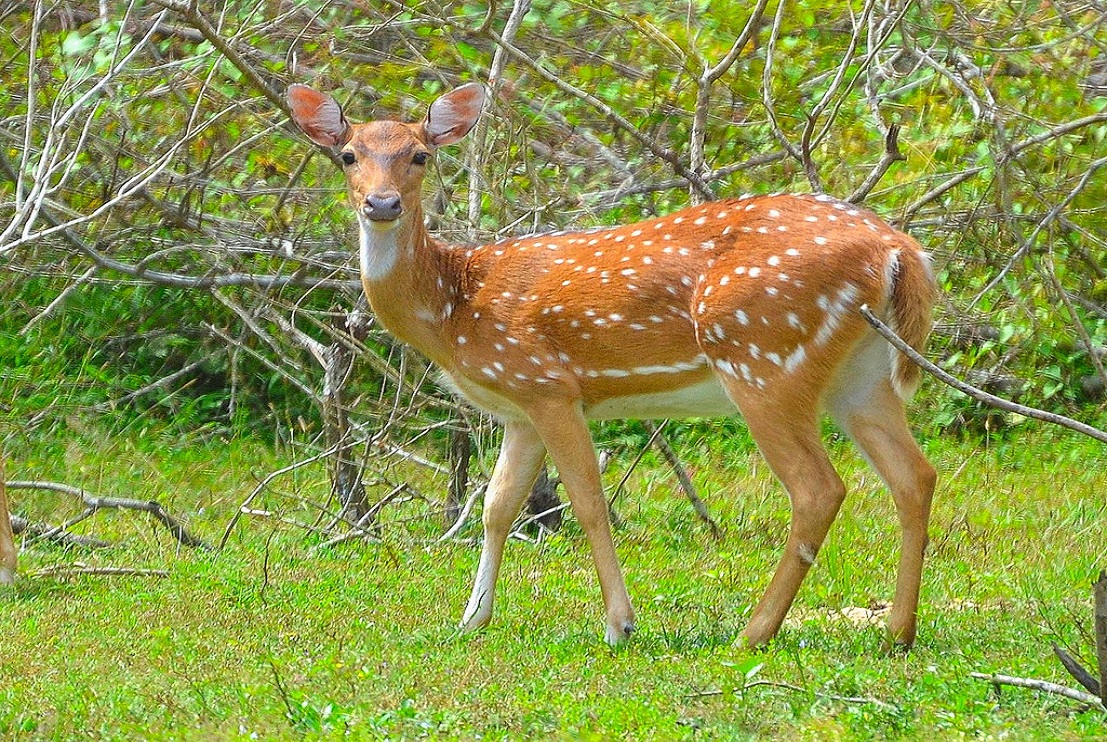Also known as the Chital and Axis Deer, the Spotted Deer is a very commonly seen wild mammal that you will see during your wildlife experiences in Sri Lanka. This species live in lowland dry forests, savannas as well as shrub lands and can be seen in big groups when you visit national parks in the dry zone of the country. However, as you move towards higher altitude areas in Sri Lanka, the sightings of these deer will remain rare.
About the Spotted Deer
Spotted Deer have a pinkish brown coat marked with white spots and the under parts of this animal remain white in color. Unlike females, the male species grow antlers, which are shed once a year. Usually, the antlers have three prongs and are curved in a lyre shape. When male spotted deer are at their prime during breeding, these antlers can extend to a whopping two and a half feet in length. These deer are also known for their delicate balancing act – standing on their hind legs to reach out for leaves and fruits on trees.
It is not an uncommon sight to see young male deer deeply engrossed in brawls with each other. In most cases, the elder matured ones resort to horning, pawing and marking. The Chital species has a very extended breeding season, particularly because of the tropical climate in Sri Lanka. Births can occur at any time throughout the year. This is the reason why antler shedding cycles of males are not synchronized and some females are fertile at all times of the year. Irrespective of size and other factors, male Chital that have hard antlers are more dominant than those that don’t have antlers and those that have soft velvet-like antlers.
The Spotted Deer are true herbivores, living only on grass, leaves and fruits. These harmless animals are seen living together in groups of about 10-16 animals. When the habitat conditions are exceptional: availability of plenty of water, grassland and vegetation, herds of more than 100 animals have been seen.
Preys and Predators
In Sri Lanka, these Axis Deer are a primary prey for Mugger Crocodiles and Sri Lankan Leopards. The Jackal often looks out for young fawns as prey. In terms of a reciprocal relationship, you will often see herds of Spotted Deer feeding near groups of Grey Langurs. This is because the Deer scan the surrounding jungle for predators on land level and the Langurs have an aerial view for scanning. Also, the Spotted Deer benefit from the Langurs again because they can easily feed on leaves and fruits that are dropped from the trees by the Langurs. The loud alarm of a Spotted Deer is most definitely a sign that a leopard is hanging around the area, waiting to prey on them.
After learning about Leopards being prime predators and Spotted Deer being their prey, you will better understand that the main reasons for higher probability of spotting Leopards at national parks such as Yala and Wilpattu is because of the direct correlation to the high number of Spotted Deer and other prey species. In other words, the longer the Chital is around, the longer the Leopards will be around. The survival of the Spotted Deer also plays a big role in the natural balancing of healthy ecosystems.
If you are an animal lover, keen on studying the Chital and many other wild animals of Sri Lanka, schedule at least a couple of weeks in the country and make sure to visit places like Yala, Wilpattu, Sinharaja, Udawalawe and Minneriya. We, at Blue Lanka Tours can help you plan and organize a holiday in Sri Lanka with more focus on exploring wildlife while also covering most of the other popular tourist attractions in the country.

